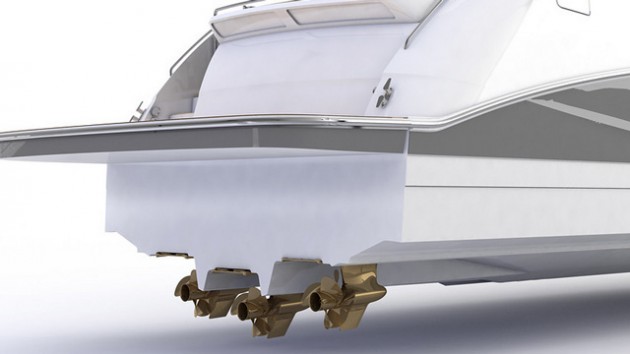Advertisement
Advertisement
Sea Ray L590 Test Run: Triple Zeus Pods In Action
We took the new L590 for a test run to find out how it performed with its triple Zeus pod drives.
December 20, 2014
Sea Ray is a builder of epic proportions, and if you've read our review of the new L590 (Sea Ray L590: Luxury Incarnate) you already know they’re walking down a new path with this boat. Or, really I should say with this yacht. Because, like its bigger sister the L650, the L590 is quite different from Sea Ray’s other offerings.

Take a gander at the L650, the first introduction in the new Sea Ray L class, and you can see it’s a departure from the norm for this builder.
The L class is set apart by the level of luxury (yes, that’s what the “L” stands for), décor, and both interior and exterior design. It’s Sea Ray’s idea of everything a yacht should be. And by all accounts—my own included—they hit the bull’s eye with these boats, which look like something straight out of Lifestyles of the Rich and Famous. Which begs the usual question: how much do these boats cost? Sea Ray’s pretty mum on the topic, so let’s just file this one under “if you have to ask you probably can’t afford it,” note that it’ll be measured in millions not thousands, and let it go at that.
Okay: so we know these are uber-nice yachts, and we know they cost an arm and a leg. But the L590 gets even farther from the norm with its power system, by utilizing triple Zeus pod drives coupled to Cummins QSC 8.3 600 in-line-six diesels, rated at 593 HP each. What gives? Won’t using triples drive down efficiency? We can learn a lesson here from outboards; while moving from single to twin screws (of equal horsepower) does cause an efficiency drop, going from twins to triples results in an efficiency boost. (See The Triple Outboard Engine Craze for more info). The same is true of pod drives. Pods are more efficient than shafts in the first place, and utilizing 1,779 horses via those three Zeus pods has a significant leg up over rigging with a pair of shafts with the same amount of power. Added bonus: you get to enjoy the other advantages of Zeus pods as well, like the easy joystick control handling, Skyhook positioning, and additional interior cabin volume. Just one question remains: How will the L590 perform with this unusual rig?

Triple Zeus pod drives and Cummins QSC 8.3 diesels may look and sound like an odd choice, but don't make any judgments until you take the L590 off the dock.
To find out, we took hull number one out into the Gulf of Mexico. Seas looked to be one to two feet and on the choppy side, thanks to a 10 to 15 knot breeze. The L590 crushed right through it without hesitation, vibrations, or banging on impact, as is to be expected from a boat of this stature. With the diesels spooling up the boat first seemed to hit its stride at about 2500 RPM, where we ran at 24.3 MPH while burning 81.4 GPH, for about a third of a mile to the gallon. While that might not sound like great mileage, let’s not forget that we’re pushing an awful lot of fiberglass through the water. Look at 60-footers in general, and you’ll find that this is about average.
What’s not average is what happened when I nailed the throttles, and took the engines up to wide-open. The GPS peaked at 36.7 MPH, which is thoroughly sporty for a boat of this size and nature. Some competitors can’t hit 30, most just touch it, and few get up over 35. Then the real fun can begin. Crank the wheel over hard, and the L590 digs in and carves turns that would make most 40-footers jealous. Crank the wheel back the other way and the bow shifts instantaneously. Swivel your head aft to sneak a peek behind the transom, and you see a tight “S” in your wake.
| Performance Data | |||
|---|---|---|---|
| Test conditions: 1 to 2 foot chop, winds 10-15 knots, 5 POB | |||
| RPM | MPH | GPH | MPG |
| 1000 | 6.5 | 4.5 | 1.44 |
| 1500 | 9.2 | 18.1 | 0.51 |
| 2000 | 15.0 | 47.8 | 0.31 |
| 2500 | 24.3 | 81.4 | 0.30 |
| 3000 | 36.7 | 97.4 | 0.38 |
| Power | Triple 593 HP Cummins QSC diesels with Zeus pod drives | ||
From the full performance chart, you'll see one more interesting tidbit of info. At WOT, the boat actually gets slightly better efficiency than it does at 2500 RPM. It’s a bit unusual but not entirely uncommon to see slightly better performance at elevated RPM, and it tells you that the L590 is best cruised at the upper end of the Cummins recommended cruising RPM range (2700) where you’ll see speeds right around 30. Yup, a true 30 MPH most-efficient cruise in a 60-foot yacht. Nice.
For more information on the L590, visit Sea Ray.
Advertisement
Related Boats for Sale
See more boats like thisAdvertisement

















